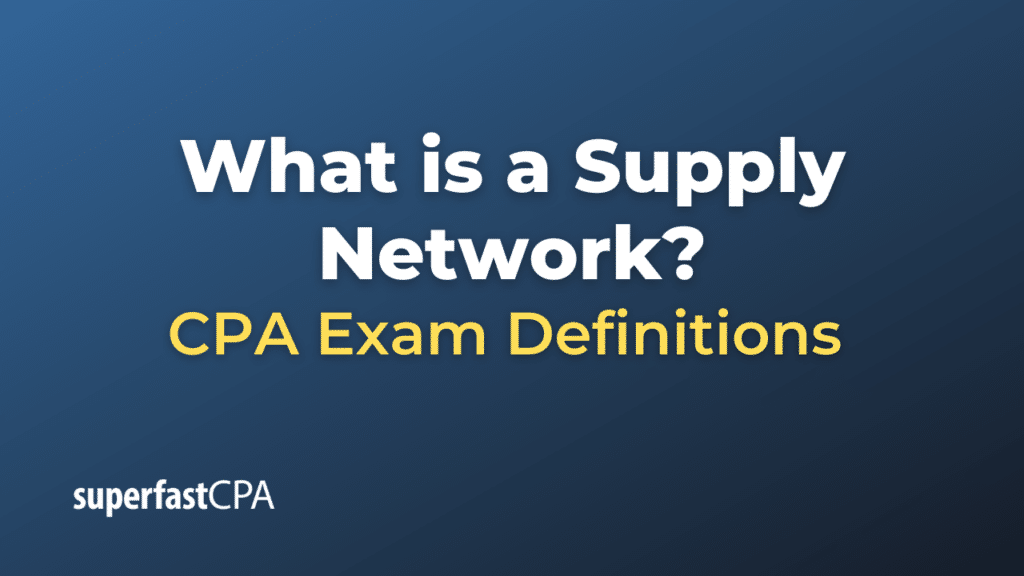Supply Network
A supply network refers to a complex system of organizations, people, activities, information, and resources involved in moving products or services from suppliers to end customers. Unlike a linear supply chain, which can be visualized as a direct sequence of processes from raw materials to the end consumer, a supply network acknowledges the fact that most supply chains are not linear but are interconnected, multi-tier systems with multiple potential paths and intersections.
Key characteristics of a supply network include:
- Complexity: In a supply network, multiple suppliers might provide similar components or materials to a manufacturer, and conversely, a single supplier might cater to several manufacturers or downstream businesses.
- Interconnectivity : Different nodes (like suppliers, manufacturers, and distributors) are connected in multiple ways, creating a web-like structure.
- Flow of Information and Materials : Information and materials don’t just flow linearly from A to B; they may move between various nodes, depending on demand, capacity, disruptions, and other factors.
- Flexibility: Supply networks are designed to be adaptable. If one path becomes obstructed (e.g., due to a supplier failure), there may be alternative paths available to maintain the flow of goods and information.
- Risk and Resilience: In a network, a disruption at one node (e.g., due to natural disasters, strikes, or geopolitical issues) can have ripple effects across the entire network. However, because of its interconnected nature, a well-designed supply network can also be more resilient, as it may have built-in redundancies and alternative paths.
- Visibility: For effective management, visibility across the entire network is crucial. Modern technologies, such as the Internet of Things (IoT) and blockchain, are enhancing the visibility and traceability of goods and transactions across these intricate networks.
Example of a Supply Network
Let’s use a real-world influenced example of a coffee supply network to better understand the concept.
Scenario: The Global Coffee Supply Network
1. Raw Material Suppliers: These are the farmers and plantations that grow coffee beans. They might be spread across different countries, including Brazil, Vietnam, Colombia, and Ethiopia.
2. Processors: Once coffee cherries are harvested, they are sent to processors who remove the fruit and roast the beans. Some large farms might do this on-site, while smaller ones might send cherries to centralized facilities.
3. Exporters: After processing, coffee beans are often sold to exporters in the producing country who handle international sales and shipments.
4. Importers/Distributors: In the consuming country, importers or distributors receive large shipments of coffee beans. They might re-bag or mix beans from different sources.
5. Brands/Retailers: Companies like Starbucks, Dunkin’, or your local coffee brand buy beans from importers. They might roast the beans further, grind them, and then sell them as packaged products or brew them for direct sale to consumers.
6. Secondary Suppliers: These include companies that provide cups, lids, sugar, milk, and other items that coffee retailers need.
7. Technology Providers: From the software that tracks shipments to the machines that brew coffee in shops, there’s a vast network of tech providers supporting the coffee industry.
8. Logistics and Transport: Multiple transportation companies, from those that operate cargo ships between continents to local trucking companies that deliver beans to your local coffee shop, play a role.
9. Consumers: From people who buy coffee beans in bulk to brew at home, to those grabbing a latte on their way to work, they’re the end of the supply network.
Now, consider the intricacies:
- A disruption in Brazil’s coffee production (due to weather or strikes) might lead Starbucks to source more beans from Vietnam or Ethiopia.
- If a shipping company faces a strike or a major route is blocked, the entire supply might be delayed, leading to shortages in stores.
- A tech glitch in the point-of-sale system at coffee shops could disrupt sales, even if there’s plenty of coffee available.
- If a health trend boosts demand for almond milk over traditional milk, the coffee shop’s supply network needs to adjust rapidly.
All these elements and their potential interactions highlight that it’s not just a linear chain. Every node can impact numerous others. A robust supply network would account for these complexities and have strategies in place to mitigate risks and take advantage of opportunities.













